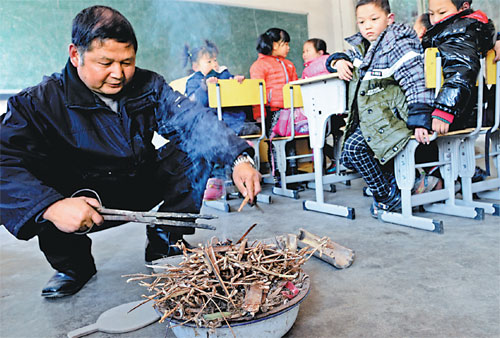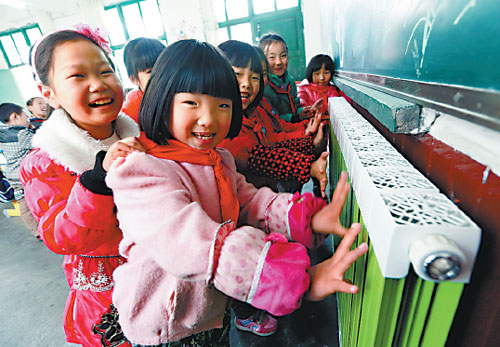Winter freeze generates heated debate
Updated: 2015-12-24 07:53
By Cang Wei(China Daily USA)
|
|||||||||
Traditionally, central heating has only been available to people in the north of China, but as climate change prompts lower temperatures nationwide, there are growing calls for its use to be extended to the south. Cang Wei reports from Nanjing.
Although his parents are expecting him to return to his hometown for Spring Festival, China's most important festival for family reunions, Liu Yueting has decided not to go, despite not having seen his parents for six months.
"It's all because of my little girl. Our 2-year-old traveled from Beijing to Nanjing with us last Spring Festival. Although my parents' house has air conditioners, she caught a bad cold because of the lack of central heating," the 35-year-old said.
"I spent more than 20 years in Nanjing without heating, but once I experienced the heating in North China, I could no longer bear the freezing winters in the south. I don't want my baby girl to spend a second Spring Festival in the hospital," he said.
When he was a child in the south of China, Liu never imagined that people could wear T-shirts and summer pajamas indoors during winter.
"In the south, the temperatures outdoor and indoor are much the same," he said. "You need to be very strong-willed to get out of a warm bed every morning. I have suggested to my parents that they move to Beijing during winter because it's much more comfortable and better for their health."
There are millions of people across South China who are not as fortunate as Liu's parents. They can't afford to move north in winter, and have been calling for central heating for years.
According to a Xinhua News Agency survey of 20,000 southern residents, more than 80 percent of respondents supported the installation of central heating in their homes. The most vociferous calls have come from residents of the "hot in summer, cold in winter" areas, spread across 14 cities and provinces, including Shanghai, Jiangsu and Zhejiang. These places, where indoor temperatures in winter are much lower than those in the north, are mainly located in the Yangtze River region and have a combined population of 150 million.
When the People's Republic of China was founded in 1949, a lack of energy and resources resulted in a decision that central heating would only be provided in the north, northeast and northwest of the country to ensure that indoor temperatures in those regions hovered between 16 C and 18 C.
Starting in the 1950s, China gradually began developing the central heating network, using the then-Soviet Union's central heating system as a model. However, under the Soviet system, winter only officially arrived when the outdoor temperature fell to 5 C, and, at the time, the only regions that met the criteria were in the north.
Historically, the south has always been slightly warmer than the north, so the decision seemed reasonable. In recent years, however, climate change has resulted in a rise in the number of days when temperatures have plummeted in the south.
According to the Bureau of Meteorology in Guiyang, Guizhou province, since 2007, the city has had about 90 days every year when temperatures have fallen below 6 C. Last year, the number reached 104. In 2008, most of Hunan province experienced subzero temperatures, and in 2009, Shanghai recorded temperatures of-8 C.
Ma Youyun, a physician at the Huai'an No 1 People's Hospital in Jiangsu province, said a range of factors affect people's sense of cold, including temperature, humidity and wind speed.
"For every 10 percent rise in humidity, people feel the temperature has fallen by about 1 degree," Ma said. "Water evaporation from the skin cools people down. Even with the same temperature nationwide, people in the south feel colder because the atmosphere there is far more humid than in the north."
Without central heating, southern residents are forced to rely on air conditioners and heaters, which are not only inadequate for the task, but also costly.
Last year, more than 17,000 households used underfloor, or radiant, heating in Hangzhou, Zhejiang province. While households without radiant heating use 150 cubic meters of natural gas during an average 75-day winter, those with it use at least 3,000 cu m during the same period, pushing the cost of heating to more than 13,000 yuan ($2,000).
Even worse, the narrow diameter of the pipelines mean the flow of natural gas is often insufficient for residents' needs.
"Radiant floor heating makes people more comfort-able compared with air conditioners," said Zhao Guoqing, deputy manager of Hangzhou Natural Gas. "Unfortunately, when the gas pipeline was first installed, floor-heating consumption wasn't taken into consideration, so the residents' use of gas for heating water and cooking has long been influenced by the limited pipeline capacity."
Pollution concerns
However, the extra winter load on power stations in the north exacerbates the already high levels of airborne pollution. Since November, large parts of North China have frequently been shrouded in choking smog, caused in part by the low-quality coal that remains the major source of power generation.
Earlier this month, Baoding, Hebei province, recorded levels of PM2.5 - particulate matter with a diameter of less than 2.5 microns, so small it can penetrate the lungs and enter the bloodstream - of about 1,000 micrograms per cu m. The World Health Organization's safe level is 30 mg per cu m.
Since Beijing's heating plants began operations in mid-November, the city has twice been forced to issue red alerts for smog, the first in the capital's history. The average PM 2.5 reading has been 241, more than three times the national safety level. Moreover, restrictions have been imposed on the use of cars, schools have been closed and sales of protective air filter masks have soared.
The lack of central heating means pollution levels are generally lower in the south of the country, where only the 14 coldest cities and provinces require extra heating for sustained periods of time, according to the Energy-Efficient Buildings Research Center at Tsinghua University in Beijing.
Shao Qing, deputy general manager of Agile Property Holdings in Nanjing, one of the city's main real estate developers, said many developers refuse to install central heating equipment because of the high cost.
"Irrespective of whether you are equipping new buildings with central heating pipelines, or installing heating systems in older buildings, it costs a lot," she said. "Of course, in the final analysis the cost will be borne by the customers."
Compared with houses and apartments in the north, those in the south are not fitted with double-glazing or an extra layer of insulating material on the exterior walls to prevent heat from escaping, according to Shao.
Failed attempts
Several moves to provide widespread central heating in the south have been unsucc-essful. As early as 2005, Wuhan, Hubei province, proposed providing central heating to 1.6 million people living within the city's 500 square kilometers, leading to a number of communities being equipped with central heating.
For several years, residents enjoyed comfortable winters, but in 2012, Qiu Baoxing, the then-deputy minister of the Ministry of Housing and Urban-Rural Development, criticized the move, saying it "posed a great danger to energy consumption". Qiu also warned that the city would be stripped of its honorary titles if it refused to reverse the decision. In response, work reports from several southern cities have stated that central heating will not be provided in the downtown areas.
Mei Peimin, director of the Department of Energy Saving and Use at the Nanjing Economy and Information Technology Commission, said the city's measures to control coal consumption mean heating is only provided to industrial enterprises and nearby residential properties.
"Coal-fired power plants and boilers have become the city's main sources of air pollution," Mei said. "We allow communities near power plants to have central heating, but no such plans have been made for residents in the downtown area. The cost of the central heating infrastructure would be enormous in Nanjing, a city with a population of 8 million. It wouldn't be worth the cost or effort to introduce central heating."
Ye Bin, deputy director of the Nanjing City Planning Bureau, said a lack of resources means it is not possible to install central heating systems. "Some industrial enterprises in Nanjing are only allowed a limited amount of electricity in summer," he said. "The measure was imposed to guarantee that there would be sufficient electricity for residents to use air conditioners. If central heating were adopted, the city's energy consumption would soar."
According to the Ministry of Housing and Urban-Rural Development, the use of central heating is not encouraged in the south. The ministry said many factors must be considered before cities launch central heating projects, and the need for heating should not override other factors, such as controlling air pollution.
"Given the limited number of days when heating is needed, and that temperatures vary in the south ... all methods of heating should be chosen scientifically," the ministry said in a public statement. "Scatt-ered and regional heating methods should be adopted to meet individual needs." The statement said "scattered and regional heating methods" include air conditioners, radiant floor heating and solar devices, and specified that clean and renewable energy projects should be encouraged.
"Small generators powered by natural gas are recomm-ended. In the first pilot program in Hangzhou, four generators manage to provide enough power for electricity, heating and 24-hour hot water in three office buildings with a combined area of 10,000 sq m," Zhao, of Hangzhou Natural Gas, said.
"It costs a lot more to install and equip small gas-powered generators, but in the long run, they are cheaper to use and far more environmentally friendly."
Contact the writer at cangwei@chinadaily.com.cn

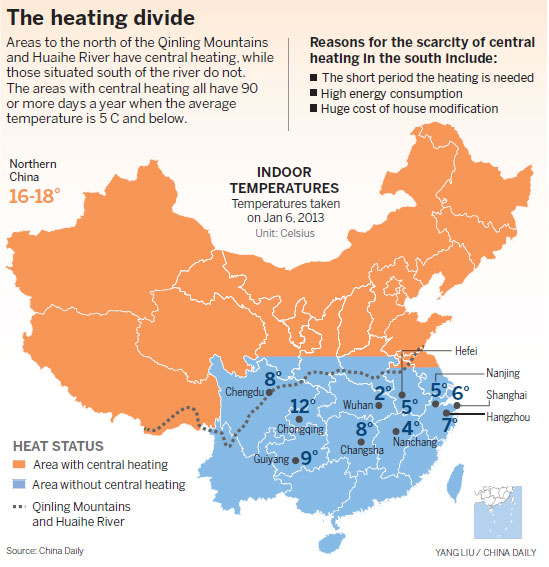
|
A teacher burns twigs and leaves to heat a classroom in Nanchang, Jiangxi, a province south of the Huaihe River. Wan Xiang / Xinhua |
|
Children gather around a new radiator in Yunyang county, Chongqing. This year, the county has installed heating systems in schools situated 800 meters above sea level. Liu Xingmin / for China Daily |
(China Daily USA 12/24/2015 page5)
- Spanish Socialist leader insists no support for Rajoy
- Yearend 2015: Heartstopping images captured by daredevils
- Iraqi forces continue offensive against IS in Ramadi
- China slams US double standards on terrorism
- Russia wants Khodorkovsky arrested abroad on murder charges
- Who's real, who's not? Can you spot the difference?
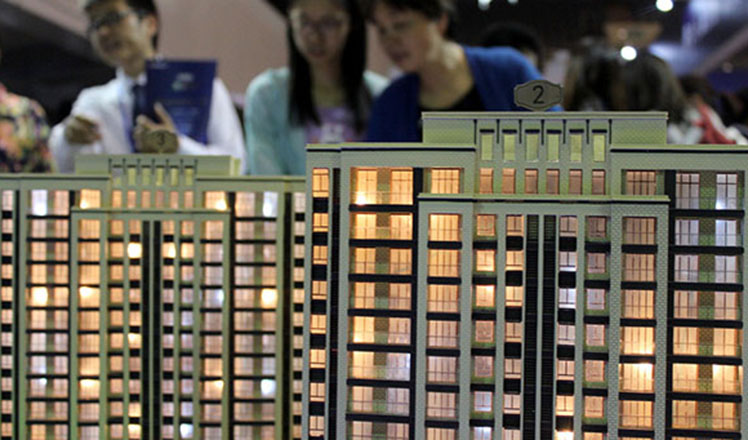
 10 major economic policies that will make a difference on lives
10 major economic policies that will make a difference on lives
 Santa Claus is busy in China
Santa Claus is busy in China
 Yearend 2015: Heartstopping images captured by daredevils
Yearend 2015: Heartstopping images captured by daredevils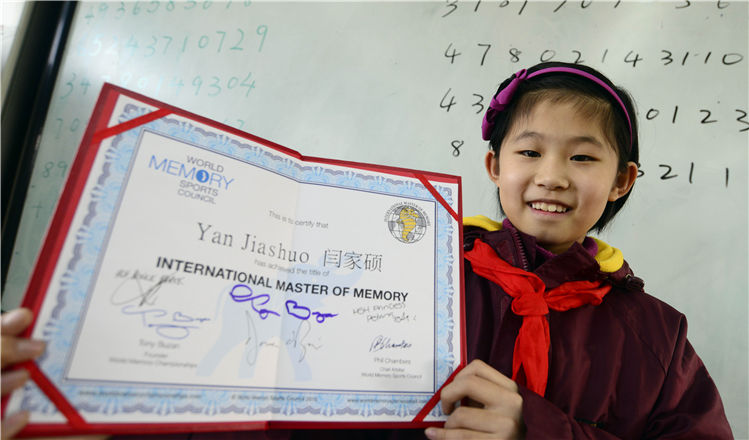
 Girl becomes youngest Master of Memory
Girl becomes youngest Master of Memory
 Whatever the shape or size of a tree, Merry Christmas!
Whatever the shape or size of a tree, Merry Christmas!
 The world in photos: Dec 14 - 20
The world in photos: Dec 14 - 20
 First American woman who works as captain for a Chinese airline
First American woman who works as captain for a Chinese airline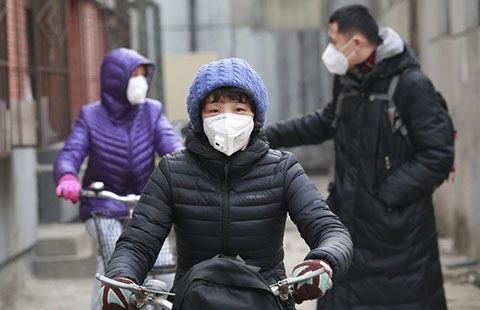
 Life of a family amid Beijing's red alert smog
Life of a family amid Beijing's red alert smog
Most Viewed
Editor's Picks

|

|

|

|

|

|
Today's Top News
Shooting rampage at US social services agency leaves 14 dead
Chinese bargain hunters are changing the retail game
Chinese president arrives in Turkey for G20 summit
Islamic State claims responsibility for Paris attacks
Obama, Netanyahu at White House seek to mend US-Israel ties
China, not Canada, is top US trade partner
Tu first Chinese to win Nobel Prize in Medicine
Huntsman says Sino-US relationship needs common goals
US Weekly

|

|
